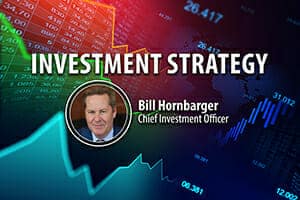By Bill Hornbarger, Chief Investment Officer
 Print This Post
Print This Post

June’s headline Consumer Price Index (CPI) report (released in mid-July) represented significant progress in the U.S. Federal Reserve’s fight against inflation. It took 15 months for the CPI to go from under 3% to over 9%. It’s taken just 12 months to go from over 9% to 3%, recently landing at that level for the first time since March 2021. That improvement is, in some part, attributable to a favorable base effect. CPI peaked last June at 9.1% amid surging energy/commodity prices and remained above 8% through the summer. One of the reasons that the Fed prefers core inflation (which excludes food and energy) is that food and energy prices tend to be very volatile.
The Fed has stated a target of 2% inflation as measured by core personal consumption expenditures (PCE). The recently reported June core PCE reading was 4.1%, and that measure has been greater than 4% since October 2021. The maximum positive impact of the base effect appears to be the three-month period we are currently in. Once we move past the year-over-year comparisons to those elevated inflation readings of last year, there is the possibility that the inflation rate could begin to trend higher. In the latest core PCE reading, the month-over-month change was 0.2%. Prior to the June reading, core PCE had only printed below that level once in the previous 27 months. For inflation to continue to trend toward the Fed’s 2% year-over-year target, a series of lower monthly changes in the inflation readings will likely be necessary. Otherwise, there is a risk that inflation will reaccelerate as fall approaches.
Surveying the more widely followed CPI’s weightings, shelter (the largest weight at 35%) had an inflation rate of 7.8% in the latest reading; owners’ equivalent rent, which is the largest portion of that, was also at 7.8%. While housing is generally considered a lagging indicator, these components merit attention going forward and will likely need to decline from current levels for inflation to continue to decelerate.
From a macro perspective, there are a number of broad factors that can be pointed to that are currently impacting the inflation outlook. Wage growth has been strong, and very recently, real (inflation-adjusted) wage growth has turned positive — and the current low unemployment rate suggests this could remain in place in the near term. Supply chain disruptions amid Covid, along with other factors, have reversed some of the globalization benefits. At the same time, consumer confidence has rebounded, and real discretionary consumer spending remains relatively stable.
The Fed recently increased interest rates again, and Fed Chairman Jerome Powell acknowledged the Fed is firmly committed to “bringing inflation back to our 2% goal and to keeping longer-term inflation expectations well-anchored. Reducing inflation is likely to require a period of below-trend growth and some softening of labor market conditions. Labor markets have remained surprisingly resilient despite the cumulative effects of 525 basis points of tightening.
The most recent projection from the Fed showed a consensus of at least one more quarter-point increase from the current level, while futures indicate that the Fed is finished raising rates for this cycle. Based on past tightening cycles, market-based indicators, and the Fed’s own rhetoric, we feel the Fed isn’t done yet and that one more increase is the most likely outcome, with an additional 50 basis points (two separate increases) a distinct possibility. We are watching the differential between fed funds and core CPI as an important indicator and want to see multiple months of a meaningful spread before declaring the Fed is finished tightening for this cycle.